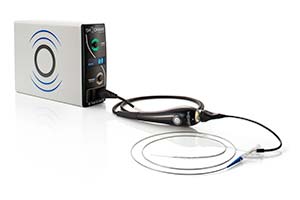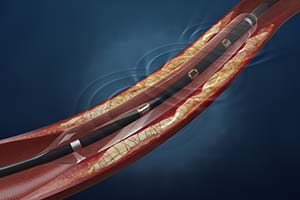San Ramon Regional Medical Center Now Offering Sonic Pressure Waves to Patients Suffering from Peripheral Artery Disease
Oct 1, 2019SRRMC one of the first hospitals in the Bay Area to perform this procedure
 San Ramon, Calif. – San Ramon Regional Medical Center is now offering a novel treatment option for those suffering from an advanced form of peripheral artery disease (PAD) in which the plaque blockage also includes the presence of calcium.
San Ramon, Calif. – San Ramon Regional Medical Center is now offering a novel treatment option for those suffering from an advanced form of peripheral artery disease (PAD) in which the plaque blockage also includes the presence of calcium.
Intravascular Lithotripsy is an innovative advanced technology that uses sonic pressure waves to modify problematic calcium so that blockage can be alleviated, and blood flow can be restored. The therapy leverages a similar minimally invasive approach that has been embraced by physicians for decades to treat kidney stones, which are also made up of calcium.
“We are thrilled to be among the first to offer this innovative technology to patients in San Ramon and surrounding areas,” said Melissa Loja, M.D., vascular surgeon at San Ramon Regional Medical Center. “Hardened calcium within peripheral artery plaque is becoming more common as people are living longer and is very challenging to treat. The sonic pressure waves produced when performing Intravascular Lithotripsy give us a novel, safe and proven treatment option to break up the calcified plaque, with potentially less risk of injury to the vessel compared to other treatments.”
 PAD affects nearly nine million people in the United States by preventing blood flow to the legs and feet, causing significant pain and limited mobility, and potentially leading to surgery or even amputation in severe cases. However, general awareness of PAD is estimated at only 25 percent based on prior studies. As the U.S. population continues to live longer, the incidence of calcium within these blockages is rising.
PAD affects nearly nine million people in the United States by preventing blood flow to the legs and feet, causing significant pain and limited mobility, and potentially leading to surgery or even amputation in severe cases. However, general awareness of PAD is estimated at only 25 percent based on prior studies. As the U.S. population continues to live longer, the incidence of calcium within these blockages is rising.
Calcium slowly develops and progresses to its hardened, bone-like state over the course of several decades of cellular growth and death in diseased plaque within the vessel walls. While it is slow to develop, its impact is immediately encountered when performing procedures to repair calcified plaques in the vessel. The calcium’s hardened structure restricts normal vessel movement and makes the rigid vascular tissue resistant to traditional balloon therapies that have been designed to compress the plaque within the vessel wall to restore normal blood flow. For these reasons, the presence of calcium increases the complexity of most cases and decreases the effectiveness of most treatments.
How Intravascular Lithotripsy (IVL) Works
Intravascular Lithotripsy uses a small generator to produce therapeutic sonic pressure waves from a catheter that is threaded through vascular system to the site of the blockage. The pressure waves are inherently tissue-selective, passing through the soft vascular tissue, preferentially disrupting the hardened calcified plaque inside the vessel wall by creating a series of micro-fractures. After the calcium has been modified, the vessel can be expanded using a low pressure balloon, thereby enabling even historically challenging PAD patients to be treated effectively with minimal injury to the vessel. For an animation of the procedure, visit www.intravascularlithotripsy.com.

